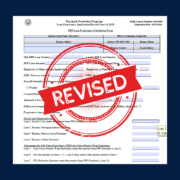PPP Loan Forgiveness Application Updated for the Flexibility Act
On June 16th, the SBA and Treasury released the revised PPP Loan Forgiveness Application. The new application is just five pages long, is said to be “borrower-friendly”, and reflects the changes implemented by the Paycheck Protection Program Flexibility Act of 2020.
The revised PPP Loan Forgiveness Application and instructions contain a number of updates, including:
- Loan recipients whose funds were disbursed prior to June 5 can now have an option for a new 24-week Covered Period or keep their original 8-week Covered Period. Loans disbursed after June 5 will only have the new 24-week Covered Period.
- Safe harbors for salary and hourly wage reductions and reductions in Full-Time Equivalents (FTE) are extended to the date the forgiveness application is submitted or December 31, rather than the original deadline of June 30, unless the 8-week Covered Period is selected.
- Retirement costs for S Corporation owners are eligible for forgiveness, but health insurance costs for S Corporation owners cannot be included in the payroll calculation.
In addition to the revised application, the SBA also introduced the EZ PPP Loan Forgiveness Application, which requires fewer calculations and less documentation for eligible borrowers. The EZ application applies to loan recipients who meet any one of these criteria:
- are self-employed with no employees,
- did not reduce the salaries or hourly wages of their employees by more than 25% during the Covered Period compared to 1/1/20 and 3/31/20 and did not reduce the number of employees or the average hours paid between 1/1/20 and the end of the Covered Period,
- did not reduce the salaries or hourly wages of their employees by more than 25% during the Covered Period compared to 1/1/20 and 3/31/20 and experienced reduced business activity due to COVID-19.
Instructions clarify that employee compensation is limited to 24/52 of $100,000 during the 24-week Covered Period (8/52 of $100,000 if the 8-week Covered Period is used). This means that up to $46,152 can qualify as forgivable employee compensation during the 24-week Covered Period.
For owner-employees, self-employed individuals and general partners using the 24-week Covered Period, compensation is limited to the 2.5-month equivalent of 2019 compensation, capped at $100,000. In this case, such an individual will have a maximum forgivable compensation of $20,833 ($100,000 divided by 12 times 2.5). It may be less if the individual had 2019 compensation below $100,000. If the 8-week Covered Period is selected, the formula is 8/52 of 2019 compensation, capped at $100,000.
Additional Items
A few of the other major changes to forgiveness requirements from the Paycheck Protection Program Flexibility Act of 2020 include:
- Lowers the portion of PPP loan funds that must be used for payroll from 75% to 60%, allowing 40% to be used toward other non-payroll, eligible costs such as rent and utilities.
- Extends the loan term of any funds not forgiven to 5 years from 2 years. Please note that for existing loans prior to the passing of this bill, both lender and borrower must agree to the change in loan terms through a refinance of the loan. The interest rate remains 1%.
- Allows businesses who qualify for loan forgiveness to also defer the employer portion of payroll tax, which would be paid in two installments (50% by 12-31-2021 and 50% by 12/31/2022)
- Changes the loan repayment deferral period to the date forgiveness is decided rather than 6 months from disbursement
The SBA and the Treasury Department are hopeful that the revised application and new EZ application will make the forgiveness process more efficient for borrowers, while making it easier for businesses to be eligible for full forgiveness of their loans.
Our team is closely monitoring this situation as updates are released. Please reach out to your trusted Scheffel Boyle team member with questions. We are always here to help.



